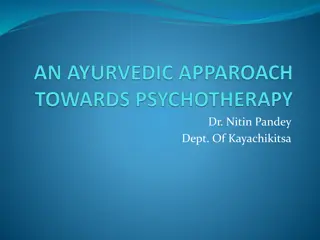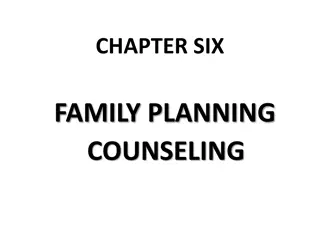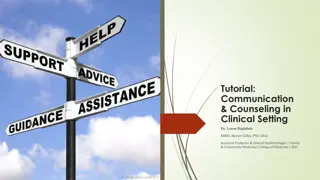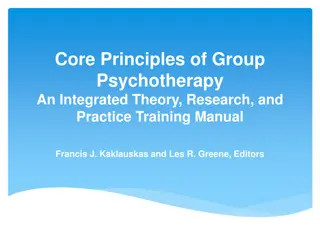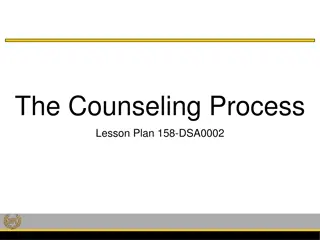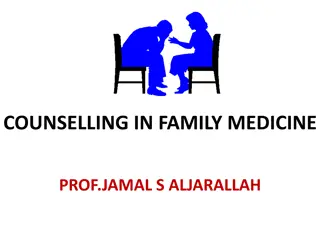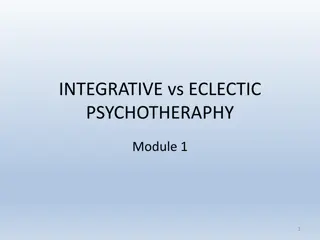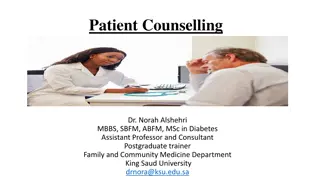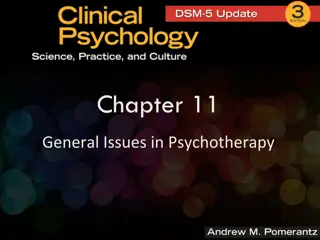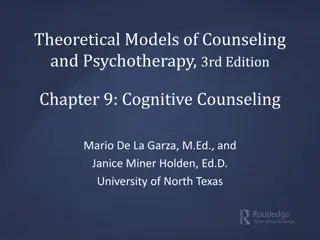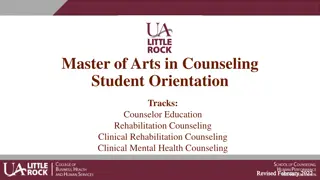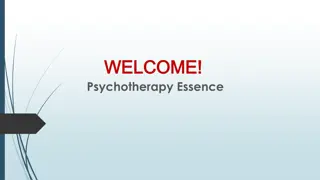Introduction to Theoretical Models of Counseling and Psychotherapy
In Chapter 1 of "Theoretical Models of Counseling and Psychotherapy," the text explores the introduction to counseling theory, discussing the advantages and similarities among different counseling theories. It also delves into the differences, explaining why no single theory is superior and how to reconcile the advantages and disadvantages of various approaches. The content emphasizes the need to consider multiple perspectives and theories in counseling practice.
Download Presentation

Please find below an Image/Link to download the presentation.
The content on the website is provided AS IS for your information and personal use only. It may not be sold, licensed, or shared on other websites without obtaining consent from the author.If you encounter any issues during the download, it is possible that the publisher has removed the file from their server.
You are allowed to download the files provided on this website for personal or commercial use, subject to the condition that they are used lawfully. All files are the property of their respective owners.
The content on the website is provided AS IS for your information and personal use only. It may not be sold, licensed, or shared on other websites without obtaining consent from the author.
E N D
Presentation Transcript
Theoretical Models of Counseling and Psychotherapy, 4th Edition Chapter 1: Introduction Mario De La Garza, Ph.D. Southern Methodist University
Counseling Theory (Advantages) Provides Order and meaning Internally consistent concepts and terms Rationale Explains How individuals develop Problems individuals face How counseling can help
Similarities among Counseling Theories People are born with certain innate tendencies and psychological functions. People are influenced by their environments. People develop due to an interaction of innate tendencies, environment, and other factors. People can function in preferable or unpreferable ways. People can develop further to a more preferable mode of functioning. Counseling can help people develop toward more preferable functioning.
Differences among Counseling Theories How people are innately endowed How people are influenced by their environments How people develop What constitutes preferable functioning How people change How counseling helps people change toward more preferable functioning
Why not one theory? Blind men and elephant picture: http://www.satrakshita.com/meditation_from_dark ness_to_light.htm Hologram diagram: http://science.howstuffworks.com/hologram.htm
Disadvantages of Counseling Theory Each theory is a reflection of the theorist s understanding of human experience and behavior. Each theory, then, becomes a filter that may Miss certain data Dismiss certain data Misinterpret certain data Deny certain data
Reconciling Advantages & Disadvantages Decide to be atheoretical. Decide to be polytheoretical. Decide to identify YOUR theory of counseling and use resources from other theories that align with YOUR theory.
Is there a superior theory? No one counseling approach has emerged superior to other approaches. Intelligent, insightful people disagree on how they see the world. Currently, the largest percentage of counselors identify with cognitive-behavioral, existential, and psychodynamic theories.
Identifying Your Guiding Theory of Counseling Even now, you would respond to a client in a counseling session based on some rationale. You already have ideas about human nature, role of the environment in personality development, healthy and unhealthy functioning, and personality change processes. Thus, you already have a counseling theory, and it probably matches one of the existing theories better than the others.
The Seven Cs of Counseling Theory Complete Clear Consistent Concrete Current Creative Conscious
Wattss Four-stage Model of Theory Identification Exploration stage Examination stage Integration stage Personalization stage
Nature/Nurture Question For most personality traits Genes explain 30% 50% of variance Environment explains 50% 70% of variance Non-shared, unique experiences have more influence than shared factors. Caregiver behavior may be the result, rather than the cause, of a child s behavior. Genes may be expressed at different ages or under specific circumstances.
Nature/Nurture Question Genetics has been linked to schizophrenia, depression, bipolar disorder, Alzheimer s disease, antisocial behavior, anxiety disorder, extreme introversion, and other phenomena for which individuals seek counseling. Prevailing view in mental health: Distressing psychological symptoms are the result of a combination of genetic vulnerability (diathesis) and environmental factors (stress).
DSM 5 Diagnosis American Psychiatric Association published the first edition of the Diagnostic and Statistical Manual of Mental Disorders in 1952. Purpose Identify categories of mental disorders Establish nationally acceptable nomenclature and descriptions of mental disorders Determine incidence rates of mental disorders
Pharmacotherapy Has been found to be less effective than psychotherapy Has been found to be as effective as psychotherapy Has been found to be more effective than psychotherapy depending on the particular study.
Managed Care and Brief Therapy Health Maintenance Organizations (HMOs) Preferred Provider Organizations (PPOs) Medicaid and Medicare Favor approaches that are brief and have been validated, in particular, cognitive-behavioral approaches
Technical Eclecticism Eclecticism: selecting what seems best from various systems Impossible to be atheoretical A polytheoretical approach is inconsistent Theoretical eclecticism versus technical eclecticism
Diversity Issues Ethnic diversity Religious diversity Sexual orientation Respecting diversity means that [counselors] are committed to acquiring the knowledge, skills, personal awareness, and sensitivity that are essential to working effectively with diverse client populations (Herlihy & Corey, 1996, p. 295). Respecting diversity is an ethical mandate of the American Counseling Association.
Effectiveness of Psychotherapy At least 50% of clients will achieve beneficial outcome in 5 10 sessions. 20% 33% of clients will need more than 25 sessions for positive outcome. Lower likelihood of success: Poor motivation Hostility History of poor relationships Passivity
Effectiveness of Psychotherapy Extratherapeutic factors Expectations of Improvement Therapeutic Relationship Therapist Techniques 15% 40% 30% 15%
Purpose of Your Theories Text Help you learn about the most prominent theories of psychotherapy Help you compare and contrast the theories to determine what is Similar between two or more theories, and Different between theories / unique to given theories Help you comparatively evaluate the research supporting the various theories Help you compare your views about how people are innately endowed, develop, and change with the views of each theorist all so that you can identify the guiding theory that best reflects your identity that is a best fit for you as a developing mental health professional.
References Fall, K. A., Holden, J. M., & Marquis, A. (2023). Theoretical models of counseling and psychotherapy (4th ed.). Routledge.




